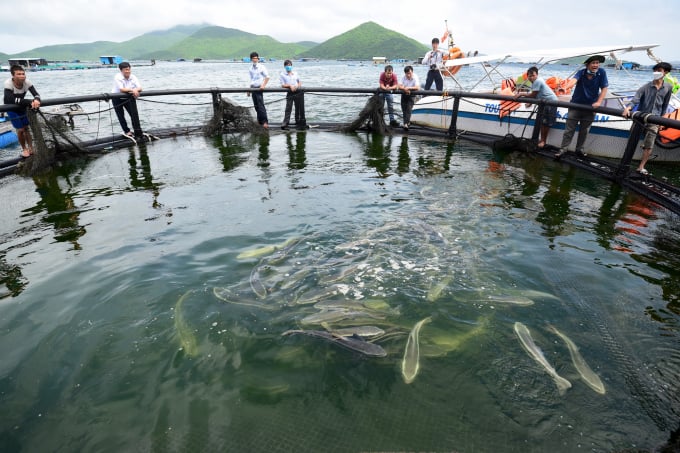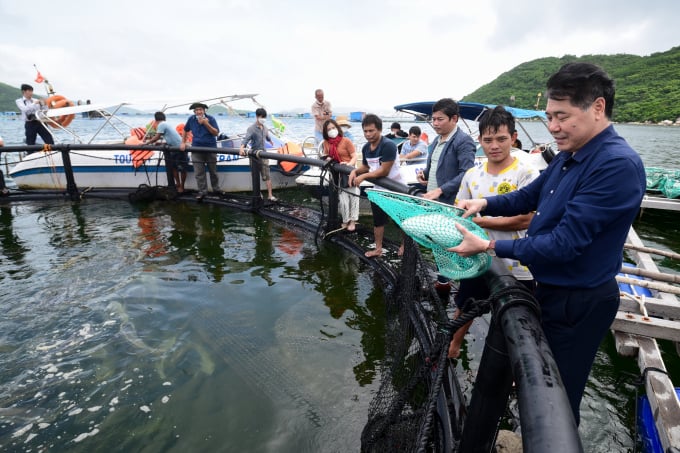November 22, 2025 | 08:29 GMT +7
November 22, 2025 | 08:29 GMT +7
Hotline: 0913.378.918
November 22, 2025 | 08:29 GMT +7
Hotline: 0913.378.918
The Government of Vietnam, in collaboration with the Government of Norway and the United Nations Development Programme (UNDP), has just organized an international conference in Hanoi on "Sustainable Ocean Economy and Climate Change Adaptation: Solutions for a Resilient Blue Economy”.

Blue economy is currently the development trend of Vietnam as well as the world. Photo: Tung Dinh.
In order to accelerate marine space planning and implement the accompanying policies, the Vietnam Administration of Seas and Islands (MONRE) and UNDP have come up with a system of analyzes and recommendations, encapsulated in the report "Blue Economy - Towards sustainable ocean economy development scenario.”
The report presented a “sustainable ocean economy development scenario for Vietnam” up to 2030, meaning a higher level of development of the baseline scenario.
The scenario harnesses outstanding benefits in terms of GDP contribution, GNI of ocean economic sectors and per capita income for marine laborers. This scenario will not only aim for sustainable development but also contribute VND 296 trillion (USD 12.9 billion) to GDP in 2025, and VND 538 trillion (USD 23.5 billion) in 2030 according to the report.
“The report states several important recommendations to promote blue economy in Vietnam, contributing to the successful implementation of ‘the 2030 Strategy for sustainable development of Vietnam's ocean economy - vision to 2045’ and the United Nations' sustainable development goals (SDG) including the SDG14 on the conservation and sustainable use of the oceans, seas and marine resources,” said Mr. Ta Dinh Thi, Vice Chairman of the Science, Technology and Environment Committee of the National Assembly, former Director General of the Vietnam Administration of Seas and Islands.

HDPE cage fish farming area of Research Institute for Aquaculture I on Van Phong Bay, Khanh Hoa. Photo: Tung Dinh.
To be more specific, the recommendations divided according to each industry group include:
- Fisheries and aquaculture: Reduce fishing volume to achieve maximum sustainable levels (approximately 2.7 million tons per year) with a 2% reduction rate annually, reflected in a 5% reduction of coastal ship horsepower per year; conservation of aquaculture area; improvement in management that lead to an increase of safe production rate of 3.5% per year.
- Petroleum: Promote energy saving in oil and gas production activities; strengthen environment protection; increase participation in the field of marine renewable energy production which has recently emerged.
- Marine renewable energy: Soon expand marine renewable energy sources reaching 10,000 MW which will be installed by 2030, including approximately 4,500 MW of nearshore wind (mainly in the Mekong Delta) and 5,500 MW of offshore wind (mainly in the South Central region).
- Tourism: Promote the growth of international visitors by 8-10%/year and domestic tourists by 5-6%/year; reach an occupancy rate of 65% by 2030; incorporate the impacts of climate change, including sea level rise, into tourism planning.
- Maritime transport: Increase sea transport to 20.6% by 2030; increase the volume of goods transported to 787 million tons and domestic transport to 289 million tons.
According to Dr. Nguyen Chu Hoi, Standing Vice President of Vietnam Fisheries Society, the scale of blue economy has expanded in recent years. The most obvious change is the formation of a number of coastal and island economic zones aiming to become a sea economic center, such as the island city in Phu Quoc, showing that the role of the “island economy” has increasingly noticeable.
“However, the scale of the blue economy in Vietnam is still small, with development incommensurate with its potential. Illegal, unreported and unregulated (IUU) fishing remains a pressing issue. Developing the blue economy therefore still requires basic and specific laws and policies concerning the marine environment to effectively implement state management, " said Dr. Nguyen Chu Hoi.
Choosing the "blue economy" is also the must-go development direction as Dr. Nguyen Chu Hoi proposed. He also recommended some policies: take measures to respond to climate change, sea level rise and ocean change manifestations; encourage the development of renewable energy; develop blue economy sustainably based on science; encourage the development of a circular economy for plastic waste, gradually turning plastic waste into a resource; increase the transfer and application of new, low-emission technologies.

The Government has issued many documents to promote the implementation of the 2030 Strategy for sustainable development of Vietnam's ocean economy - vision to 2045. Photo: Tung Dinh.
Translated by Samuel Pham

(VAN) Results from the Sustainable Durian Model Project in Dak Lak have confirmed the critical role of Yara Viet Nam in transferring advanced nutritional solutions to farmers.

(VAN) In Tuyen Quang province, livestock farmers have introduced effective models and innovative practices that significantly strengthen African Swine Fever prevention and control efforts.

(VAN) This is the study conducted by IRRI and Can Tho University on the rice straw value chain in Mekong Delta showing an economic potential of more than 6.6 trillion VND/year.

(VAN) By participating in cooperative economics, many farmers in Tay Ninh have overcome hardship, mastered clean dragon fruit cultivation techniques.

(VAN) The crossbreeding program in the former Binh Dinh province (now part of Gia Lai) has shown signs of decline, and urgent measures are needed to revive it and sustain past achievements.

(VAN) The agricultural sector agreed on a roadmap to pilot the MRV protocol and expand low-emission rice production from the 2025-2026 winter-spring crop.

(VAN) Agricultural extension officers in Quang Ninh do more than transmit knowledge; they have become a steadfast support system for farmers on the path to sustainable agricultural development.